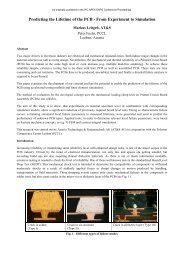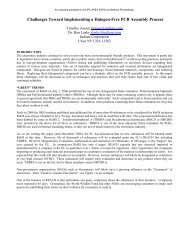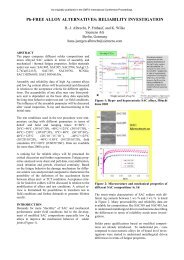No-Clean Flux Residue and Underfill Compatibility ... - IPC Outlook
No-Clean Flux Residue and Underfill Compatibility ... - IPC Outlook
No-Clean Flux Residue and Underfill Compatibility ... - IPC Outlook
You also want an ePaper? Increase the reach of your titles
YUMPU automatically turns print PDFs into web optimized ePapers that Google loves.
As originally published in the <strong>IPC</strong> APEX EXPO Proceedings.<br />
<strong>No</strong>-<strong>Clean</strong> <strong>Flux</strong> <strong>Residue</strong> <strong>and</strong> <strong>Underfill</strong> <strong>Compatibility</strong> Effects on Electrical Reliability<br />
Eric Bastow<br />
Indium Corporation<br />
Utica, NY<br />
<strong>No</strong>-clean soldering processes dominate the commercial electronics manufacturing world. With the explosion of growth in<br />
h<strong>and</strong>held electronics devices, manufacturers have been forced to look for ways to reinforce their assemblies against the<br />
inevitable bumps <strong>and</strong> drops that their products experience in the field. One method of reinforcement has been the utilization<br />
of underfills to “glue” certain surface mount devices (SMDs) to the PCB. This provides additional mechanical strength over<br />
<strong>and</strong> above the soldered connections. Bumped SMDs attached to the PCB with a no-clean soldering process offer the<br />
unavoidable scenario of the underfill coming in contact with a flux residue. This may or may not create a reliability issue.<br />
<strong>No</strong>-clean solder paste flux chemistries can vary. Some have halogens <strong>and</strong> others do not. Some have st<strong>and</strong>ard residues <strong>and</strong><br />
others have residues optimized for pin probing. There are also a number of underfill chemistries on the market. Furthermore,<br />
underfill curing conditions vary depending on whether the SMDs are exposed on the surface of the PCB or underneath an RF<br />
shield. This paper will discuss an experiment designed to measure the electrical reliability of various combinations of<br />
underfill <strong>and</strong> no-clean flux residues, as measured with J-STD-004B SIR (<strong>IPC</strong>-TM-650 2.6.3.7).<br />
Procedural Backgroup <strong>and</strong> Set-Up<br />
For the experiment, a matrix of three different Pb-Free, no-clean solder pastes <strong>and</strong> four different underfills were used. The<br />
individual materials (solder pastes <strong>and</strong> underfills) were tested by themselves, as well, in order to establish the baseline<br />
performance for each.<br />
The solder pastes are described as the following:<br />
1) Halogen-containing with a st<strong>and</strong>ard residue<br />
2) Halogen-free with a st<strong>and</strong>ard residue<br />
3) Halogen-free with a residue optimized for pin-probing<br />
<strong>No</strong>te: All pastes contained the SAC305 alloy (96.5%Sn 3.0%Ag 0.5%Cu)<br />
The four underfills are described by the respective manufacturers as follows:<br />
1) <strong>Underfill</strong> A – is a reworkable underfill encapsulant for CSP <strong>and</strong> BGA encapsulation that cures quickly at low<br />
temperature. It is capable of flowing quickly across distances of 750 mils <strong>and</strong> greater. This encapsulant exhibits<br />
excellent adhesion to organic substrates.<br />
2) <strong>Underfill</strong> B - is a reworkable underfill encapsulant for CSP <strong>and</strong> BGA encapsulation that cures quickly at low<br />
temperature. It is capable of flowing quickly across distances of 750 mils <strong>and</strong> greater. This encapsulant exhibits<br />
excellent adhesion to organic substrates.<br />
3) <strong>Underfill</strong> C - is a reworkable underfill encapsulant for CSP <strong>and</strong> BGA encapsulation that cures quickly at low<br />
temperature. It is capable of flowing quickly across distances of 750 mils <strong>and</strong> greater. This encapsulant exhibits<br />
excellent adhesion to organic substrates.<br />
4) <strong>Underfill</strong> D – reworkable epoxy underfill is designed for CSP <strong>and</strong> BGA applications. It cures quickly at moderate<br />
temperatures to minimize stress to other components, <strong>and</strong> when cured provides excellent mechanical stress<br />
protection for solder joints.<br />
<strong>No</strong>te: The author’s company does not manufacture underfills. These underfills were sourced from two world class underfill<br />
manufacturers <strong>and</strong> the individual chemistries were selected for this experiment based upon their popularity.<br />
Since the experiment seeks to measure the “compatibility” of the no-clean solder pastes residues <strong>and</strong> underfills based on<br />
surface insulation resistance (SIR) performance, the <strong>IPC</strong>-B-24 SIR test coupon was used as the test vehicle. Each test coupon<br />
contains four SIR patterns. Two <strong>IPC</strong>-B-24 SIR test coupons (a total of eight SIR patterns) were prepared <strong>and</strong> tested for each<br />
individual material <strong>and</strong> solder paste/underfill combination.<br />
Furthermore, an additional objective of underst<strong>and</strong>ing what impact “entrapment” under an RF shield has on the SIR<br />
performance of such combinations was incorporated into the experiment. Two SIR patterns, patterns B <strong>and</strong> D, on each <strong>IPC</strong>-<br />
B-24 SIR test coupon were covered with RF shields. Every <strong>IPC</strong>-B-24 SIR test coupon, whether using solder paste alone,<br />
underfill alone, or a solder paste/underfill combination, was prepared with the RF shields affixed in place - both during solder
As originally published in the <strong>IPC</strong> APEX EXPO Proceedings.<br />
paste reflow <strong>and</strong> underfill curing. The RF shields were cleaned with isopropyl alcohol before being used. Figures 1 <strong>and</strong> 2 are<br />
photographs of the RF shields that were used.<br />
Figure 1 - Unfolded RF Shield<br />
Figure 2 - Folded RF Shield<br />
The following photograph (Figure 3) shows the location of the RF shields <strong>and</strong> thermocouples as used for establishing the<br />
solder paste reflow profile <strong>and</strong> underfill cure profiles.
As originally published in the <strong>IPC</strong> APEX EXPO Proceedings.<br />
Figure 3 - <strong>IPC</strong>-B-24 SIR Test Coupon showing location of thermocouples <strong>and</strong> RF shields<br />
Figure 4 shows the profile used to reflow the three solder pastes. The thermocouples, identified in the reflow profile as TC 2<br />
<strong>and</strong> TC 5, were located on the SIR patterns under the RF shields. Those identified as TC 3 <strong>and</strong> TC 4 were located on the<br />
exposed SIR patterns. The exposed SIR patterns achieved a peak temperature of ~249°C <strong>and</strong> the SIR patterns covered with<br />
the RF shields achieved a peak temperature of ~244°C.<br />
Figure 4 - Solder Paste Reflow Profile
As originally published in the <strong>IPC</strong> APEX EXPO Proceedings.<br />
The following were the manufacturer recommended cure cycles for the respective underfills:<br />
1) <strong>Underfill</strong> A – 165°C for 5 minutes<br />
2) <strong>Underfill</strong> B – 150°C for 1 to 6 minutes<br />
3) <strong>Underfill</strong> C – 150°C for 3 to 6 minutes<br />
4) <strong>Underfill</strong> D – 130°C for ≥ 8 minutes<br />
Figures 5, 6, <strong>and</strong> 7 show the underfill cure profiles that were obtained using a set-up similar to what is depicted in Figure 3.<br />
For underfills B <strong>and</strong> C, the same cure profile was used (Figure 6). <strong>No</strong> care was taken to identify which thermocouples were<br />
located under the RF shields <strong>and</strong> which were located on the exposed SIR patterns. Presumably the patterns under the RF<br />
shields would have achieved a slightly lower peak temperature than those located on the exposed SIR patterns.<br />
Figure 5 - Cure Profile used for <strong>Underfill</strong> A<br />
Figure 6 - Cure Profile used for <strong>Underfill</strong>s B <strong>and</strong> C
As originally published in the <strong>IPC</strong> APEX EXPO Proceedings.<br />
Figure 7 - Cure Profile used for <strong>Underfill</strong> D<br />
Procedure<br />
For the two SIR test coupons prepared for each solder paste, the paste was stencil printed onto the test coupons using a stencil<br />
that is in accordance with the <strong>IPC</strong> prescribed stencil parameters. Then an RF shield was affixed over patterns B <strong>and</strong> D on<br />
each of the two SIR test coupons (see Figure 8). The SIR test coupons were then submitted to the reflow profile depicted in<br />
Figure 4. Figure 9 shows the SIR test coupon after it was reflowed. Figure 10 shows the reflowed SIR test coupon with the<br />
RF shields removed.<br />
Figure 8 - SIR Test Coupon Showing Printed Paste <strong>and</strong> RF Shields Affixed Over Patterns B <strong>and</strong> D
As originally published in the <strong>IPC</strong> APEX EXPO Proceedings.<br />
Figure 9 - Pasted SIR Test Coupon after Reflow<br />
Figure 10 - Pasted <strong>and</strong> Reflowed SIR Test Coupon with RF Shields Removed<br />
For the two SIR test coupons prepared for each underfill, the underfill was dispensed onto the test coupons (see Figure 11).<br />
The underfill was then mechanically moved around to cover the entire SIR pattern with a razor blade (see Figure 12). Next,<br />
an RF shield was affixed over patterns B <strong>and</strong> D on each of the two SIR test coupons (see Figure 13). The SIR test coupons<br />
were then submitted to the specific cure profile as prescribed by the underfill manufacturer (Figures 5, 6, <strong>and</strong> 7). Figures 14<br />
<strong>and</strong> 15 show the cured underfill SIR test coupons with RF shields affixed <strong>and</strong> removed, respectively.
As originally published in the <strong>IPC</strong> APEX EXPO Proceedings.<br />
Figure 11 - Dispensed <strong>Underfill</strong> on the SIR Test Coupon<br />
Figure 12 - Smeared <strong>Underfill</strong> Covering Entire SIR Pattern
As originally published in the <strong>IPC</strong> APEX EXPO Proceedings.<br />
Figure 13 - <strong>Underfill</strong> Covered SIR Test Board with RF Shields Affixed<br />
Figure 14 - Cured <strong>Underfill</strong> Test Coupon with RF Shields Affixed
As originally published in the <strong>IPC</strong> APEX EXPO Proceedings.<br />
Figure 15 - Cured <strong>Underfill</strong> SIR Test Coupon with RF Shields Removed<br />
For the two SIR test coupons prepared for each solder paste/underfill combination, the solder paste was printed <strong>and</strong> reflowed<br />
in the same manner as the SIR test coupons prepared with solder paste only. Then the RF shields were removed <strong>and</strong> underfill<br />
was applied to each SIR pattern in the same manner as the SIR test coupons prepared with underfill only. The RF shields<br />
were reaffixed to their original locations <strong>and</strong> the SIR test coupon was submitted to the appropriate underfill cure profile.<br />
Upon completion of the preparation of all the SIR test coupons (solder paste only, underfill only <strong>and</strong> solder paste/underfill<br />
combination) all RF shields were removed. The SIR test coupons were then tested per the SIR test conditions <strong>and</strong> methods as<br />
prescribed per J-STD-004B. SIR measurements were taken every 20 minutes. The SIR measurements for the four exposed<br />
SIR patterns were averaged, <strong>and</strong> the SIR measurements for the four RF shield covered SIR patterns were averaged (from the<br />
two SIR test coupons prepared for each material or combination) <strong>and</strong> graphed as a function of resistance versus time.<br />
Following are the graphs. (Given the highly resistive nature of the flux residues <strong>and</strong> underfills, taking measurements at low<br />
voltage is subject to a certain amount of system “noise”. From time to time upward <strong>and</strong>/or downward spikes will be observed<br />
in the graphs. In such cases, one should focus on the general trend of the graph instead of the “noise”.)
Results<br />
As originally published in the <strong>IPC</strong> APEX EXPO Proceedings.
As originally published in the <strong>IPC</strong> APEX EXPO Proceedings.
As originally published in the <strong>IPC</strong> APEX EXPO Proceedings.
As originally published in the <strong>IPC</strong> APEX EXPO Proceedings.<br />
<strong>No</strong>te: Three of the eight SIR patterns produced values below the <strong>IPC</strong> required minimum value of 1x10^8 ohms per square.<br />
The effect of averaging makes the plotted lines stay higher.
As originally published in the <strong>IPC</strong> APEX EXPO Proceedings.
As originally published in the <strong>IPC</strong> APEX EXPO Proceedings.
As originally published in the <strong>IPC</strong> APEX EXPO Proceedings.
As originally published in the <strong>IPC</strong> APEX EXPO Proceedings.<br />
<strong>No</strong>te: One of the eight SIR patterns produced values below the <strong>IPC</strong> required minimum value of 1x10^8 ohms per square. The<br />
effect of averaging makes the plotted line stay higher.
As originally published in the <strong>IPC</strong> APEX EXPO Proceedings.
As originally published in the <strong>IPC</strong> APEX EXPO Proceedings.
As originally published in the <strong>IPC</strong> APEX EXPO Proceedings.<br />
Observations <strong>and</strong> Conclusions<br />
It was observed that <strong>Underfill</strong> B produced a unique visual anomaly as can be seen in Figure 16. This anomaly was especially<br />
pronounced on the SIR patterns that were covered with RF shields. It is not known whether the underfill looked this way after<br />
curing or not until after SIR testing. <strong>No</strong>ne of the other underfills exhibited this sort of phenomenon.<br />
Figure 16 - Anomaly in <strong>Underfill</strong> B, Post SIR Testing (RF Shield Pattern)
As originally published in the <strong>IPC</strong> APEX EXPO Proceedings.<br />
In a previous work, the author studied the impact of RF shields on no-clean flux residues. In that work, the results showed<br />
that entrapping a flux residue under an RF shield consistently produced lower SIR results than residues that were fully<br />
exposed (not covered). In that work, the RF shields were larger, produced a better seal (restricted outgassing), noticeably<br />
reduced the peak temperature of the SIR patterns below the shields, <strong>and</strong> were left on the patterns during SIR testing. In this<br />
study, certain materials <strong>and</strong> combinations, especially the underfills, seemed to benefit (produce higher SIR values) when<br />
covered with an RF shield. However, in this study, the RF shields were smaller, did not create a seal (see the corners of the<br />
RF shields in Figure 2), did not significantly reduce the peak temperature of the reflow <strong>and</strong> cure profile of the SIR patterns<br />
below the shield, <strong>and</strong> were removed prior to the SIR test. Therefore, it is unclear just what sort of impact these RF shield<br />
have on the results <strong>and</strong> how well they mimic a real world scenario. The author believes that the results in the previous work<br />
are more true to reality.<br />
<strong>Underfill</strong> C produced poor SIR results. The poor SIR performance of <strong>Underfill</strong> C was transposed onto the SIR performance<br />
of the solder paste/underfill C combinations. Based upon the shape of the graphs (decreasing SIR performance with time), it<br />
would appear that <strong>Underfill</strong> C is somehow sensitive to the SIR chamber test conditions (temperature, humidity, <strong>and</strong>/or<br />
applied voltage).<br />
Solder paste/underfill combinations involving an underfill with good SIR performance <strong>and</strong> a solder paste with good SIR<br />
performance produced a combination with good SIR performance. <strong>No</strong> chemical “incompatibilities” between the solder paste<br />
flux vehicles <strong>and</strong> the underfills were detected. The SIR results of the solder paste/underfill combinations logically follow the<br />
SIR results of the parent materials. Keeping in mind the adage that electricity follows the path of least resistance; if one<br />
material performs poorly by itself, it will cause the combination to perform poorly regardless of the performance of the other<br />
material(s) in the combination.<br />
If an underfill/paste combination is causing current leakage, both materials should be investigated separately to determine the<br />
culprit material. The combination should not be lightly dismissed as “incompatible”. Furthermore, one should not<br />
immediately assume that one material is the problem <strong>and</strong> not the other(s) without first investigating the materials separately.
















